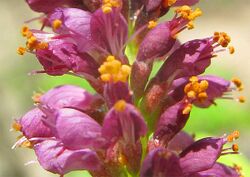Biology:Amorpheae
| Amorpheae | |
|---|---|

| |
| Amorpha fruticosa | |
| Scientific classification | |
| Kingdom: | Plantae |
| Clade: | Tracheophytes |
| Clade: | Angiosperms |
| Clade: | Eudicots |
| Clade: | Rosids |
| Order: | Fabales |
| Family: | Fabaceae |
| Subfamily: | Faboideae |
| Clade: | Meso-Papilionoideae |
| Clade: | Dalbergioids |
| Tribe: | Amorpheae Boriss. 1964 emend. Barneby 1977[1] |
| Subclades and genera | |
|
See text | |
| Synonyms | |
| |
The tribe Amorpheae is an early-branching clade within the flowering plant subfamily Faboideae or Papilionaceae. It is found from Mexico to Argentina .[2] It was recently found to belong in a larger clade known informally as the dalbergioids sensu lato.[2][3][4] This tribe is consistently resolved as monophyletic in molecular phylogenetic analyses.[2][3][4][1][5][6][7][8][9][10] It is estimated to have arisen 36.9 ± 3.0 million years ago (in the Eocene).[6] A node-based definition for Amorpheae is: "the MRCA of Psorothamnus arborescens and Eysenhardtia orthocarpa."[6] The tribe exhibits the following morphological synapomorphies: "epidermal glands throughout the plant body; dry, indehiscent fruits that are single-seeded; and terminal inflorescences."[1]
Subclades and genera
Amorphoids
The amorphoids can be distinguished from the daleoids on the basis of their non-papilionaceous flowers.[1]
- Amorpha L.
- Apoplanesia C. Presl
- Errazurizia Phil.
- Eysenhardtia Kunth
- Parryella Torr. & A. Gray
Daleoids
The daleoids can be distinguished from the amorphoids on the basis of their generally papilionaceous corollas.[1]
- Dalea L.
- Marina Liebm.
- Psorothamnus Rydb.
References
- ↑ 1.0 1.1 1.2 1.3 1.4 "Phylogeny of Amorpheae (Fabaceae: Papilionoideae)". Am J Bot 91 (8): 1219–1230. 2004. doi:10.3732/ajb.91.8.1219. PMID 21653479.
- ↑ 2.0 2.1 2.2 Wojciechowski MF. (2013). "Towards a new classification of Leguminosae: Naming clades using non-Linnaean phylogenetic nomenclature". S Afr J Bot 89: 85–93. doi:10.1016/j.sajb.2013.06.017.
- ↑ 3.0 3.1 "Revisiting the phylogeny of papilionoid legumes: new insights from comprehensively sampled early-branching lineages". Am J Bot 99 (12): 1991–2013. 2012. doi:10.3732/ajb.1200380. PMID 23221500.
- ↑ 4.0 4.1 "Reconstructing the deep-branching relationships of the papilionoid legumes". S Afr J Bot 89: 58–75. 2013. doi:10.1016/j.sajb.2013.05.001.
- ↑ LPWG [Legume Phylogeny Working Group] (2013). "Legume phylogeny and classification in the 21st century: progress, prospects and lessons for other species-rich clades". Taxon 62 (2): 217–248. doi:10.12705/622.8. https://www.zora.uzh.ch/id/eprint/78167/1/Taxon_2013_217-248.pdf.
- ↑ 6.0 6.1 6.2 "Evolutionary rates analysis of Leguminosae implicates a rapid diversification of lineages during the tertiary". Syst Biol 54 (4): 575–94. 2005. doi:10.1080/10635150590947131. PMID 16085576.
- ↑ "Phylogenetic supermatrix analysis of GenBank sequences from 2228 papilionoid legumes". Syst Biol 99 (12): 1991–2013. 2006. doi:10.1080/10635150600999150. PMID 17060202.
- ↑ "Phylogenetic relationships of basal papilionoid legumes based upon sequences of the chloroplast trnL intron". Syst Bot 55 (5): 818–836. 2001. doi:10.1043/0363-6445-26.3.537. http://www.bioone.org/doi/abs/10.1043/0363-6445-26.3.537.
- ↑ "A phylogeny of the chloroplast gene rbcL in the Leguminosae: taxonomic correlations and insights into the evolution of nodulation". Am J Bot 84 (4): 541–554. 1997. doi:10.2307/2446030. PMID 21708606.
- ↑ "Phylogenetic systematics of the tribe Millettieae (Leguminosae) based on chloroplast trnK/matK sequences and its implications for evolutionary patterns in Papilionoideae". Am J Bot 87 (3): 418–30. 2000. doi:10.2307/2656638. PMID 10719003.
Wikidata ☰ Q4747727 entry
 |

